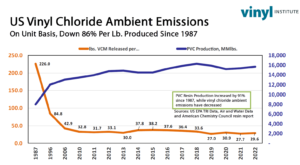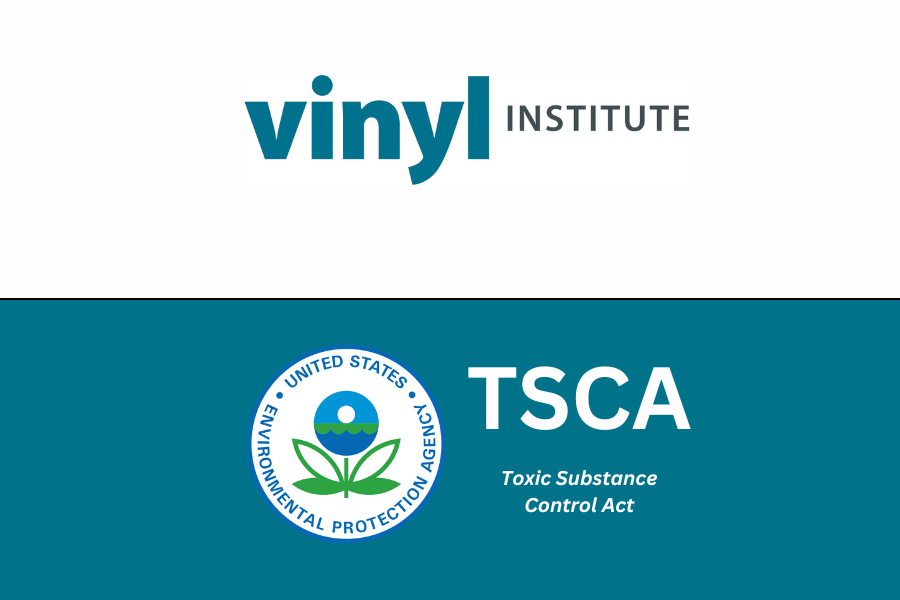This website uses cookies so that we can provide you with the best user experience possible. Cookie information is stored in your browser and performs functions such as recognising you when you return to our website and helping our team to understand which sections of the website you find most interesting and useful.
News
The Facts about Vinyl Chloride and EPA’s TSCA Classification
On July 24th, EPA announced that it would move ahead with classifying vinyl chloride as a high-priority substance for risk evaluation under the Toxic Substance Control Act. This was a widely expected move that begins a multi-year evaluation process. Some groups have touted this as a victory even though this is a procedural move that has been expected for years. We’d like to take this opportunity to explain how widely studied the production and uses of vinyl chloride really are, as well as highlight the improvements the industry has made to the safety of the production process and the safety of PVC products themselves.
There is an extensive body of research and data about vinyl chloride that will support the risk evaluation. This is an opportunity to correct any misunderstanding about the regulation of vinyl chloride manufacturing and the safety of PVC products. We believe this risk evaluation will further assure that the production of vinyl chloride and use of PVC products are safe.
Vinyl chloride is an essential commodity chemical produced in heavily regulated facilities in the United States, providing great benefits that apply to a broad spectrum of products. Federal regulations limit the potential presence of residual vinyl chloride in PVC resin. As a reactant feedstock, vinyl chloride enables effective and sustainable solutions that the U.S. government is seeking to address the climate crisis, to ensure human rights through the United Nations Sustainable Development Goals (SDGs), and to protect national interests with respect to critical infrastructure and domestic manufacturing capacity. It is critical to note that vinyl chloride is essential to the manufacture of these materials, notably PVC, which enable vital end uses and solutions for society, including:
- Drinking water pipe
- Irrigation pipe
- Sanitation pipe
- Well casings
- Safe electrical cable jacketing
- Medical devices including IV bags and medical tubing
- Energy-efficient windows and roofing membranes
- Air filtration for clean rooms and wind turbines
- Battery separators
- Lightweight automotive materials improving vehicle fuel efficiency
- Landfill liners
- Other geomembrane applications important to environmental protection
- Metal coatings
- Insulation for energy-efficient appliances
Decades of investment in new process design, equipment reliability, engineering controls, ongoing compliance with federal EPA and OSHA regulations, and other safety measures to protect workers and the communities we serve have led to significant reductions in emissions and exposures.
Since 1974, the industry has a demonstrated track record of improving the health, safety, and environmental profile of VC production, as well as its use as the main feedstock in the production of PVC. As noted in the Toxicological Profile for Vinyl Chloride recently published by ATSDR:
Over the past several decades, significant reductions in vinyl chloride emissions have been achieved from improved engineering controls in PVC manufacturing facilities. Moreover, optimization of the PVC production process has lowered residual levels of vinyl chloride in finished products such as PVC pipe and food and nonfood packaging material.
Source: U.S. Dept. of Health and Human Services: Agency for Toxic Substances and Disease Registry, Toxicological Profile for Vinyl Chloride (Jan. 2024), p. 138.
Data reported to EPA’s own Toxics Release Inventory (TRI) Program demonstrate the steep decline in VC releases since the 1980s while U.S. PVC production has increased, as illustrated below.

Employers also are mandated to conduct exposure monitoring in addition to emissions monitoring. Companies must conduct initial VC monitoring to determine the extent of VC exposure in their workplace, including determining if there is any employee exposed, without regard to the use of respirators, in excess of the action level. The results of this initial monitoring assist employers in identifying areas of operation that may need additional effort to reduce worker exposure. If initial monitoring exceeds the standard’s action levels, then increased monitoring is required. VC exposure monitoring, at least quarterly, is required if monitoring results show that worker exposures are above the Permissible Exposure Limit (PEL), while those exposed at or above the action level must be monitored no less than semiannually.
Additional monitoring is required if there is a change in VC production, process or control that may increase the release of VC. This periodic monitoring program assists employers in evaluating the effectiveness of selected control methods and reminds both the employee and the employer of the need to protect from overexposure. A 2023 report from the European Chemicals Agency found that workplace monitoring data collected indicated compliance with Occupational Exposure Limits and that appropriate medical registries recorded no angiosarcoma cases since workplace controls were implemented, concluding that “operational conditions and risk management measures implemented in the VCM/PVC industry are adequate and effective to control the risk for workers from EDC and VCM.” The U.S. vinyl industry is already operating at permitted levels which are at or below those set in Europe.
Beyond the numerous regulations and industry improvements that have led to reductions in emissions and increased employee safety during the VCM production process, vinyl products themselves also adhere to stringent requirements and certifications. PVC pipe is a great example. NSF/ANSI/CAN 61 is the only American National Standard addressing the human health effects of drinking water system components. As an approved standard of the American National Standards Institute and Standards Council of Canada, NSF/ANSI/CAN 61 is the legally recognized national standard in the United States and Canada for the human health effects assessment of drinking water contact materials, components and devices. The standard has been updated regularly to add testing criteria for additional contaminants and product types – and PVC pipe has consistently been approved as a safe, clean deliverer of drinking water.
We strive to continue our decades-long track record of innovation and improvement with the purpose of ensuring the safe production of vinyl chloride and the products made from it now and for decades to come. Our industry has invested heavily in making dramatic improvements since regulations were introduced. Vinyl chloride production is safe. Vinyl products are safe and provide best-in-class results that are not matched by other products or materials. We’re confident that this risk evaluation will conclude that VCM and vinyl products are safe.


